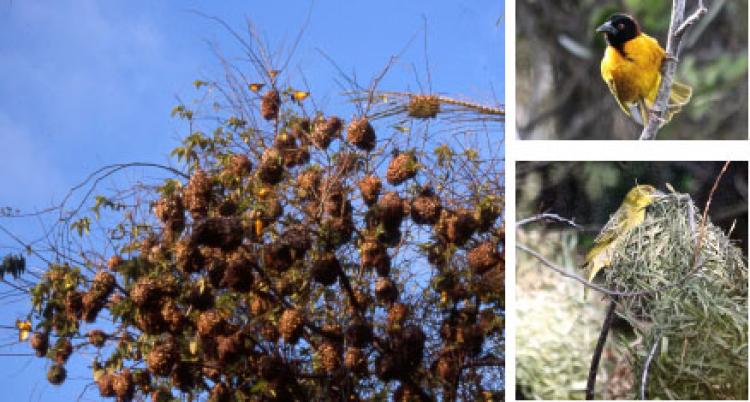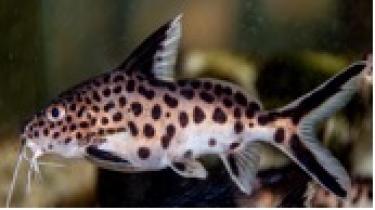
Ecology, Evolution, and Behavior of Birds and Fishes
My research focuses on biological problems with an ecological, behavioral, or evolutionary slant. Areas of interest include brood parasitism in fishes and birds, avian community structure, impact of noise on avian communities, reproductive biology of fishes, and biogeography of Mexican herpetofauna.
Current and recently completed research projects
Shiny Cowbird-Host interactions in the West Indian region – an area of recent contact. Recent changes in the range of the Shiny Cowbird (Molothrus bonariensis Fig. 1), a brood parasite, have brought it into contact with avian communities that have never experienced brood parasitism. Originally confined to South America, Trinidad and Tobago, cowbirds have dramatically spread into the West Indies during the past century. This coevolving system, set in a natural time sequence of parasite and host populations, provides an opportunity to examine cowbird impacts and adaptations against brood parasitism present in the actual and potential hosts of the cowbird on islands where it is a recent arrival (Hispaniola, Puerto Rico, St. Lucia), and in areas where the cowbird is a native member of the avifauna (Trinidad and Venezuela).

Fig. 1. Male and female Shiny Cowbirds (left), Yellow-shouldered Blackbirds (center) – host species in Puerto Rico, and Yellow-shouldered Blackbird nest with 11 cowbird and one blackbird eggs. Photos– T. Nakamura and E. Ventosa.
Egg Rejection Behavior in a Population Exposed to Parasitism: Village Weavers on Hispaniola. Recognition and rejection of foreign eggs is a behavior used by many avian taxa exposed to brood parasitism. In Africa, the high levels of rejection of non-mimetic eggs by Village Weavers (Ploceus cucullatus) are thought to have evolved as a response to Diederik cuckoo (Chrysococcyx caprius) parasitism. In contrast to African weavers, introduced Hispaniolan weavers existed without parasitism for at least two centuries until the arrival of the Shiny Cowbird (Molothrus bonariensis) in the 1970s (Fig. 2). In an earlier study (Evolution 1982), we found that weavers accepted cowbird and dissimilar weaver eggs and that cowbird parasitism reduced weaver productivity. These circumstances provided a “natural experiment.” Has rejection increased in the presence of parasitism by cowbirds? From 1999 to 2002, we experimentally parasitized weaver populations in the Dominican Republic. We predicted that weavers would accept mimetic weaver eggs but would reject non-mimetic weaver and cowbird eggs, but that there would be interpopulation differences in levels of rejection, with higher levels of cowbird egg rejection in areas where cowbirds were present. Our results show that Village Weavers on Hispaniola reject foreign eggs in their nests with increasing frequency as these eggs become increasingly different from those in the nest. We suggest that the differences in egg rejection behavior we observed may be the result of behavioral changes in egg rejection resulting from parasitism by cowbirds. This view is supported by the higher rejection of cowbird eggs that we found in the central and northern regions, an area where cowbirds were frequently observed. Thus egg rejection has not necessarily decreased in Hispaniolan weavers, but it may act in a plastic manner, increasing in frequency in areas were cowbirds are present. However, even in cases where phenotypic plasticity exists, genetic variation may be present and response to the selective pressure of brood parasitism.

Fig. 2. Village Weaver colony and male and female weavers, Dominican Republic.
Collaborators: Dr. Pablo F. Weaver pweaver@laverne.edu, Dr. James W. Wiley jwwiley@umes.edu
Brown-headed Cowbird Brood Parasitism at an urban/wildland interface – the Colorado Front Range. Brown-headed Cowbirds (Molothrus ater) are generalist obligate brood parasites that use songbirds to incubate their eggs, brood their young, and provide parental care, and in so doing they often reduce the reproductive success of many of their hosts. We examined cowbird-host interactions and spatial and temporal activity patterns of cowbirds at an urban/wildland interface in Boulder County, Colorado. We monitored over 950 songbird nests of 16 species that served as hosts in ponderosa pine and adjacent habitats. Five species had parasitism rates greater than 10%. The Plumbeous Vireo (Fig. 3) was the main host with over 54% of nests (n = 125) parasitized, followed by the Warbling Vireo (38%, n = 32), Spotted Towhee (19%, n = 21), Western Tanager (15%, n = 74), and the Blue-gray Gnatcatcher (11%, n = 26). Parasitized Plumbeous Vireo nest fledged fewer young (0.5) than unparasitized nest (2.1). The high incidence of parasitism and low fledgling success of vireos suggest that this may be a “sink” population and that immigration of individuals from a highly reproductive (“source”) population augment the vireo population. We found that cowbirds used the urban areas for foraging and roosting and traveled into ponderosa pine habitats in the morning to parasitize songbird hosts. Cowbird abundance decreased with distance from the urban/wildland interface, and vireo nests closer to the urban/wildland boundary were more likely to be parasitized than those farther away. Surprisingly some species that served as cowbird hosts elsewhere (e.g. the Western Wood-Pewee) were rarely used as hosts (<1%, n = 259 nests). Differences in patterns of nest attentiveness and spatio-temporal patterns of foraging may account for the differences.

Fig. 3. Plumbeous Vireo nest parasitized by Brown-headed Cowbird (spotted eggs).
Collaborators: Dr. Jameson Chace http://www.salve.edu/users/dr-jameson-chace, Dr. Heather Swanson SwansonH@bouldercolorado.gov, Dr. John Walsh john@interplanenvironment.com
Impact of noise on avian community structure. Noise pollution (hereafter “noise”) has been implicated as a cause in the decline of avian species densities and has been shown to reduce avian community diversity and disrupt natural species interactions (Francis et al. 2009 Current Biology). Acoustic masking of communication signals has been proposed as one of several mechanisms responsible for these observed patterns, especially for birds (Fig. 4). However, few studies to date have made attempts to link the patterns thought to result from the impact of noise and the underlying mechanistic causes. We are studying the influence of species’ vocal attributes in explaining nest site selection and ecological services in response to noise within piñon-juniper woodlands of Northwestern New Mexico. Using observations, vegetation surveys and pollen transfer and seed removal experiments, we found that effects of noise pollution can reverberate through communities by disrupting or enhancing these ecological services. Specifically, noise pollution indirectly increased artificial flower pollination by hummingbirds, but altered the community of animals that prey upon and disperse Pinus edulis seeds, potentially explaining reduced P. edulis seedling recruitment in noisy areas (Francis et al. Proc. R. Soc. B 2012. Because the extent of noise pollution is growing, this study emphasizes that investigators should evaluate the ecological consequences of noise alongside other human-induced environmental changes that are reshaping human-altered landscapes.

Figure 4. Influence of Noise on Nesting Community – Francis et al. 2009 Current Biology19:1415-19.
Collaborators: Dr. Clinton Francis, PI http://bio.calpoly.edu/content/clinton-francis Nathan Kleist nathan.kleist@gmail.com, Dr. Catherine Ortega ortega_cp@yahoo.com
The Cuckoo Catfish – a model system for studying host-parasite interactions.

Fig. 5. The Cuckoo Catfish – an obligate brood parasite from Lake Tanganyika.
Obligate brood parasitism (the use of hosts for providing care to the parasitic progeny) has great evolutionary and ecological significance. It was thought that this system occurred only in birds and insects. However, Sato (1986 Nature 323:58-5) found that the Lake Tanganyikan cuckoo catfish (Synodontis multipunctatus Fig. 5) is a brood parasite of mouthbrooding cichlid fishes. The catfish spawn in synchrony with the cichlids, laying and fertilizing their eggs for the female cichlid to pick up. Catfish eggs are brooded in the host mouth with the host eggs, but hatch earlier and feed upon host fry (Fig. 6). The catfish at the early stage of development not only depend upon their host for food and protection, but also exploit host parental investment. Other than brood parasitic birds, this catfish is the only known case of an obligate brood parasite among vertebrates (Cruz, A. et al. 2004. Pp. 180-182 in Encyclopedia of Animal Behavior. Greenwood Press). This is an important finding as it provides a model system for the study of brood parasitism in a laboratory setting, where questions about parasitism can be rigorously addressed. Since selection is both spatially and temporally focused in the breeding area, factors affecting the development of host-parasite interactions are easily discernible. Additionally, although the cuckoo catfish is parasitic, congeners are not. Thus through comparison with its non-parasitic relatives, evolutionary changes in behavioral and developmental pathways leading to parasitism can be studied. Finally, in the laboratory the catfish can parasitize cichlids from other lakes. This attribute makes it an excellent choice to elucidate the role of learned versus evolved behavior in host response. Thus the cuckoo catfish has unique advantages as a model system in evolutionary, behavioral, developmental biology, and host-parasite interactions. We are involved in an in-depth study of this system.

Fig. 6. Cuckoo catfish (small) and cichlid host eggs (large). Catfish fish eggs are brooded in the host mouth (buccal cavity), but hatch earlier and feed on the host fry, dpf = days postfertilization.
Collaborators: Dr. Marcus Cohen marcus.cohen@mac.com, Dr. David Stockdavid.stock@colorado.edu, Brent Hawkins michaelbrenthawkins@fas.harvard.edu. Rob Roscow robert.roscow@colorado.edu, Anna Vinton annacvinton@gmail.com
Evolution of Livebearing fish (genus Limia) in the West Indies: Phylogeny, diversification, and breeding behavior. Livebearing fishes of the West Indian endemic Limia genus (Fig. 7) are a potential showcase for evolution on islands, exhibiting extensive diversity in their morphology, behavior, ecology, and distribution. Our study addresses phylogeny, colonization, diversification, physiological tolerance, and breeding behavior (Pablo F. Weaver Ph.D. dissertation CU Boulder 2015). As part of our study, we are addressing mate choice and sexual selection, including geographic variations in mating preferences and possible mechanisms for the evolution of such variations.



Fig. 7. Limia sulphurophila left, Limia perugiae center, (both-Dominican Republic) and new Limia species right (Haiti).
Collaborators: Dr. Pablo F. Weaver pweaver@laverne.edu, Carlos Rodriguez carlosrguez96@gmail.com, Arlen Marmolejo arlenina82@yahoo.com, Julia Dupin julia.dupin@Colorado.EDU
Amphibians and Reptiles of northern Mexico. In conjunction with Dr. Julio Espinal, PI, we are involved in a study of the distribution, biogeography, and natural history of the herpetofauna of northern Mexico (Fig. 8). Dr. Lemos-Espinal is professor of biology, Estudios Superiores Iztacala of the National Autonomous University of Mexico (UNAM) in Mexico City.

Fig. 8. Book covers of Amphibians and Reptiles of Sonora, Chihuahua, and Coahuila, Mexico 2015, V. 1 & 2 J. A. Lemos Espinal, H. M. Smith, J. R. Dixon, and A. Cruz – 2015, and Amphibians and Reptiles of the Sierra Tarahumara, Mexico J. A. Lemos Espinal, H. M. Smith, and A. Cruz – 2014.
Collaborators: J. A. Lemos Espinal (P. I.)- lemosj44@yahoo.com.mx amd H. M. Smith deceased.

